Wednesday, December 27, 2006
Gerald Ford, R.I.P. too but...

If you call yourself a so-called hip hop blogger and you're not paying CRAZY homage to James Brown right now, you're not a hip hop blogger. Think about it....
"Forget Dylan and Elvis. James Brown was the most important American popular musician ever" - click here for more from "He Made the World Funky" by Jody Rosen in Slate magazine:
Kelefa on the Godfather.
(Image and links above via O-Dub)
Plus:
Incredible footage of James Brown live in Olympia (WA?) in 1966. (spotted via Modculture.com)
A snip of an article about the realtionship between the funk of James Brown and afro beat of fellow legend Fela Kuti by my dude Jeremy Pam:
"No sooner did Fela begin to develop highlife-jazz, however, than a musical tidal wave swept across Africa (as well as the African diaspora worldwide): James Brown. By the mid-1960s, James Brown was already recognized as a titan of rhythm and blues, "Soul Brother No. 1." With "Out of Sight" in 1964 and "Papa's Got a Brand New Bag" the following year, however, Brown took a radical turn away from traditional R&B/soul. Largely abandoning traditional song structure, Brown instead increasingly foregrounded complex, ever-changing arrangements of simple rhythmic patterns or vamps played by his razor-sharp horn and guitar sections, all over polyrhythmic foundations laid down by his drummers Clyde Stubblefield, Jabo Starks and Melvin Parker (brother of the late Columbia Law professor Kellis Parker).
Brown's famous account of the making of "Papa's Got a Brand New Bag" in his autobiography is perhaps the best description of this seminal development in American popular music: "I was still called a soul singer but musically I had already gone off in a different direction. I had discovered that my strength was not in the horns, it was in the rhythm. I was hearing everything, even the guitars, like they were drums. I had found out how to make it happen."
Alfred "Pee Wee" Ellis to introduce congas into Brown's band and was an inspiration behind the arrangement of many of the Brown's most rhythmically innovative compositions, such as "There Was a Time," Give It Up Or Turnit a Loose," and "Super Bad."
The result of these revolutionary musical experiments – which eventually became known as funk – at first seemed shockingly "unmusical" to many white Americans (and to some black Americans as well). In Africa, by contrast, although prompting similar incomprehension and disapproval among a few self-appointed cultural gatekeepers, James Brown's new sound almost immediately became wildly popular, and in West Africa soon began to undercut the audience for highlife.
In addition to its symbolic appeal as a newly assertive expression of black Americans' ongoing struggle for human rights (in such songs as "Say It Loud, I'm Black and I'm Proud"), some musicologists have explained the African popularity of Brown's music as stemming from certain structural commonalities with traditional West African rhythmic patterns, particularly variations on the generic West African patterns known as "clave" (which are also central to Afro-Cuban and other Afro-Carribean musical styles). For Fela, the wild popularity of James Brown's music posed a significant challenge.... "
(Click here to download the entire article.)
A ridiculous number of JB-related links at WFMU's Beware of the Blog.
And Stone's round-up of James Brown blog tributes.
Tweet

































